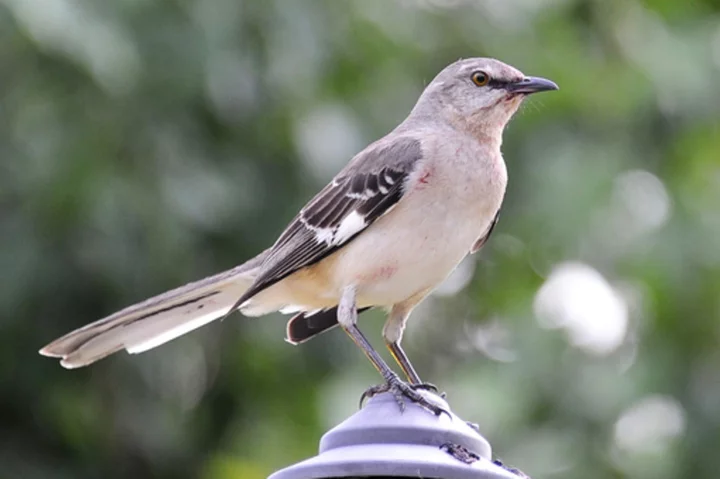I was sitting in solitude earlier this summer in an Adirondack chair in my backyard, when I realized I wasn't as alone as I'd thought.
Thanks to the app I'd just downloaded on my phone — the popular and free Merlin Bird ID — I learned just from listening that I was surrounded by more than a dozen species of birds. Where before I had simply heard birdsong, I now realized how rich the variety was in that single moment.
I ran Merlin's “Sound ID” feature for half an hour. At first, the usual suspects for my neighborhood outside of Boston popped up: robins and blue jays, ubiquitous throughout the Eastern U.S. and easily recognizable. Then other birds, like the northern cardinal and the goldfinch.
As the minutes passed, more birds joined the list. Chimney swift, northern flicker, fish crow, killdeer, Baltimore oriole and gray catbird among them. One bird had a red dot next to its name; it was a veery, a warm-colored thrush, and the dot meant it was a rare sighting. Then a great horned owl appeared on my screen, again with a red dot.
Who knew all these birds could be in one yard?
As the annual fall migration begins across the Northern Hemisphere, apps like Merlin, which is put out by the Cornell Lab of Ornithology, have caught on among birders and non-birders alike by revealing just how crowded with species our surroundings are.
It has turned a neophyte like me into an obsessive about birds and the world they’ve opened in my life.
BIRDING BY EARBirding's popularity soared during the pandemic, when people were eager to get outside and the outdoors became, briefly, a quieter place in which to hear birdsong and other sounds of nature.
First released in 2014, Merlin rode that wave of interest. The number of users grew 67 percent by the first spring of the pandemic compared to a year earlier, Cornell said. But then Sound ID was released in June 2021, and the number of users skyrocketed.
More than 7 million people now use the app worldwide, and “we've more than doubled the number of users in the last year," said Alli Smith, a project coordinator for Merlin.
Other bird-identifying apps include the Audubon Bird Guide, ChirpOMatic, Picture Bird and Smart Bird.
“Birding by sound opens up a whole new world. Even if you can’t see the skulky hermit thrush hiding in the brush or the Baltimore oriole high in the trees, you can hear their beautiful songs and know they’re there sharing your neighborhood,” Smith said.
There are over 700 species that Merlin’s Sound ID can identify in the U.S. alone.
And in the weeks I've used it, I’ve noticed more than just birds.
CONNECTING WITH PEOPLE, TOOWhen I posted a screenshot of my bird list on social media, friends who also used the app messaged me about it. Through Merlin and backyard birdwatching, I’ve reconnected with two childhood friends halfway across the country. (Merlin doesn’t have a social media-type feature within the app.)
We joke that Merlin is the equivalent of the Pokémon Go app but for older folks.
My sister-in-law in Montana has an entirely different crop of birds than I see in the Northeast. She seems to have more hawks and raptors, but she will also share a picture of a colorful hummingbird.
Connection is a frequent theme when people give Merlin feedback, said Smith.
“Birding is a surprisingly social hobby and people are so excited about what they are seeing,” she said. “There are so many little wonders around and it’s fun to share that with people."
LEARNING ABOUT THE LARGER OUTDOORSBefore Merlin, I’d always assumed the distinct “coo” I heard was from a mourning dove. It’s an owl. Common rookie mistake.
Listening and watching birds has made me more aware of the times of day, and times of year, when certain birds become more active. Healthy environments too, of course, attract more birds.
“You can see the seasons," said John Smallwood, a biology professor with an expertise in ornithology at Montclair State University.
"You’re looking at birds but you can’t help but see everything else too,” he said. “You see the entire ecosystem.”
Some bird-watchers upload their sightings into eBird, a scientific database that tracks avian populations, which have declined sharply overall in past decades.
“We know that people protect what they care about, and you really only care about what you know,” said Smith. “So Merlin is our way of making learning about birds available and accessible to everybody.”
HAVING THE KIDS JOIN IN — SOMEWHATIf it takes technology to peel kids away from the screen and interested in the outdoors, so be it.
My two kids — in particular my tween son — love to make fun of my nerdy interests, but they’ve learned some things about birds from Merlin. Maybe they didn’t mean to, but I see it.
Anytime they hear an unfamiliar bird call, they scramble for my phone to find out what it is.
We learned from watching the National Geographic series “Extraordinary Birder with Christian Cooper,” which also airs on Disney Plus, that there is no such thing as a singular pigeon or seagull. When we are in the city or at the beach, my kids are reaching for the phone to see what kind of pigeons or seagulls are nearby.
As of now, my Life List on Merlin is 45 birds. My kids are the drivers for getting more on the list.









